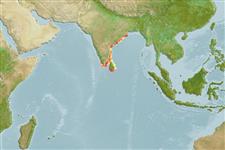>
Scombriformes (Mackerels) >
Trichiuridae (Cutlassfishes) > Trichiurinae
Etymology: Lepturacanthus: Greek, leptos = thin + Greek, oura = tail + Greek, akantha = thorn (Ref. 45335).
Environment: milieu / climate zone / depth range / distribution range
Ecologia
marino; salmastro benthopelagico; distribuzione batimetrica 0 - 80 m (Ref. 6181). Tropical; 21°N - 5°N, 76°E - 87°E (Ref. 6181)
Indian Ocean: Hooghly estuaries to Gulf of Mannar in the east coast of India.
Size / Peso / Age
Maturity: Lm ? range ? - ? cm
Max length : 92.0 cm TL maschio/sesso non determinato; (Ref. 6181); common length : 40.0 cm TL maschio/sesso non determinato; (Ref. 6181)
Short description
Morfologia | Morfometria
Spine dorsali (totale): 3; Raggi dorsali molli (totale): 121-131; Spine anali 2; Raggi anali molli: 74 - 84. Body extremely elongate, compressed and tapering to a point. Anal fin reduced to a long spine and 74 - 84 smaller spinules; pelvic and caudal fins absent. Lateral line running nearer the ventral contour than the dorsal contour of the body. Body color steely blue with metallic reflections in fresh specimens, becoming silvery gray after death.
Benthopelagic or pelagic in estuaries and coastal waters. Feeds on a wide variety of small fishes and crustaceans chiefly on prawns, young clupeoids, Harpodon nehereus and Trichiurus spp. in Hooghly estuaries, India. Caught mainly with bag nets in estuaries, with shore seines and boat seines in inshore waters, and with trawls in off-shore waters. Marketed fresh as well as dried salted.
Life cycle and mating behavior
Maturità | Riproduzione | Deposizione | Uova | Fecundity | Larve
Nakamura, I. and N.V. Parin, 1993. FAO Species Catalogue. Vol. 15. Snake mackerels and cutlassfishes of the world (families Gempylidae and Trichiuridae). An annotated and illustrated catalogue of the snake mackerels, snoeks, escolars, gemfishes, sackfishes, domine, oilfish, cutlassfishes,. scabbardfishes, hairtails, and frostfishes known to date. FAO Fish. Synop. 125(15):136 p. (Ref. 6181)
IUCN Red List Status (Ref. 130435)
Threat to humans
Harmless
Human uses
Pesca: scarso interesse commerciale
Informazioni ulteriori
Nomi ComuniSinonimiMetabolismoPredatoriEcotossicologiaRiproduzioneMaturitàDeposizioneSpawning aggregationFecundityUovaEgg development
Age/SizeAccrescimentoLength-weightLength-lengthLength-frequenciesMorfometriaMorfologiaLarveDinamica popolazioni larvaliReclutamentoAbbondanzaBRUVS
BibliografiaAcquacolturaProfilo di acquacolturaVarietàGeneticaElectrophoresesEreditarietàMalattieElaborazioneNutrientsMass conversion
Strumenti
Special reports
Download XML
Fonti Internet
Estimates based on models
Phylogenetic diversity index (Ref.
82804): PD
50 = 0.6250 [Uniqueness, from 0.5 = low to 2.0 = high].
Bayesian length-weight: a=0.00191 (0.00078 - 0.00466), b=3.11 (2.90 - 3.32), in cm total length, based on LWR estimates for this (Sub)family-body shape (Ref.
93245).
Trophic level (Ref.
69278): 4.1 ±0.71 se; based on food items.
Resilienza (Ref.
120179): Medio, tempo minimo di raddoppiamento della popolazione 1.4 - 4.4 anni (Preliminary K or Fecundity.).
Fishing Vulnerability (Ref.
59153): High vulnerability (57 of 100).
